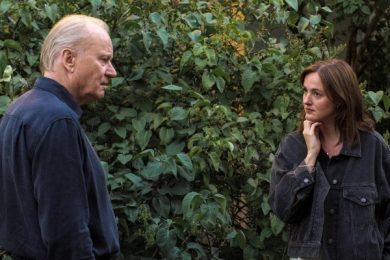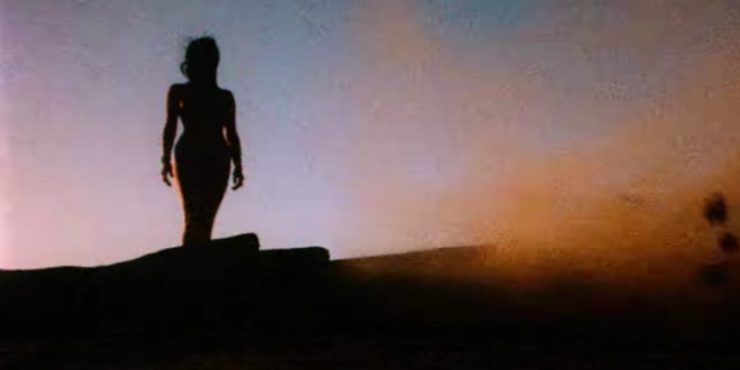I’d imagine that most people who get around to The Other Side of the Wind – which is now available on Netflix – will wonder if this is a mess of a film, only hailed as a triumph because its director happens to be Orson Welles. The fact is that both things are true: the film is a mess, but it is a quintessentially Wellesian mess, and that makes it a kind of triumph. Much has been said and written about the troubled production of Wind – though for those more curious, there’s nothing better than Josh Karp’s wonderfully-researched book Orson Welles’ Last Movie – and moreover, the redundancies between the film’s plot and the details of its maligned shoot make explaining it mostly a moot point. With The Other Side of the Wind finally here, after 40 years of mishaps and scandal, the lines between fact and fiction blur flagrantly as Welles proves able to make magic out of mayhem.
Welles picks another legendary Hollywood director, John Huston, to play Jake Hannaford, a renowned director with a cherished, decades-long career that is nearing its end. His latest film, also called ‘The Other Side of the Wind’, hasn’t finished shooting, but its leading man, John Dale (Bob Random), has vanished after walking out on the set and the money is starting to run thin. A screening of the current edited footage is arranged on Jake’s birthday, with the hopes that someone there will be willing to foot the rest of the bill. At the screening is his large group of cronies, including Brooks Otterlake (Peter Bogdonavich) a Hannaford protegé who has gone on to surpass his mentor in commercial success, Matt Costello (Paul Stewart) who works as Hannaford’s bag man and is the self-appointed leader of the “Hannaford mafia”, and Billy (Norman Foster) a candy fiend and professional stooge who is probably the most shameless beggar for end money.
Not everyone at the screening is a friend. There’s Juliette Riche (Susan Strasberg), a feisty film critic looking for any angle to undermine Jake’s beloved career – and a Pauline Kael stand-in. There’s also Max David (Geoffrey Land), a hotshot studio boss who very much does not like what he sees so far from Hannaford’s latest film – a riff on Robert Evans. Wind is mostly an ensemble, slapped together documentary style with so many characters coming in and out of the film that it’s difficult to keep track of all the people flocking around Jake. The screening is plagued by power outages, explosions of male ego, changes of venue and even at one point a display of rifle shooting. The whole event unfolds in frenetic, uneven passages, often cross-cutting with other locations and even at times with the film-within-a-film.
The Other Side of the Wind, as it stands, is a film that feels obviously unfinished, filled with shots and characters cut to look like they’re in the same room together when it’s obvious that they are, in fact, not. This is an incredibly shrewd trick that Welles plays, knowing how the artifice of his film would play against the themes of Classic Hollywood burning up in the face of the fresher, cooler New Hollywood. With characters stuck between the traditions of the past and the excitement of the future, Welles happens to produce a feature that satirizes both of them in equal measure, and populating the film with various film personalities – or their facsimile – adds another dimension to Wind‘s psychedelic docudrama feel.
Oja Kodar, the co-writer of Wind‘s script and Welles’ lover for the last portion of his life, is an actress in the film and also plays an actress in Hannaford’s film (her character is never given a name, but is occasionally called ‘Pocahontas’). Kodar is mostly a symbol of regal, exotic beauty who doesn’t speak and tramps around aimlessly, often completely naked in Hannaford’s opaque, abstract film segments (tossing up the atmosphere of Antonioni, Hannaford’s Wind is a feisty little dig within Welles’ larger portrait). Kodar’s erotic performance and her presumably adventurous narrative contributions creates a film much unlike anything else Welles has ever done. In terms of structure, Wind is nothing like his other narrative features, which are often built atop very specific archetypes, such as Shakespeare or Kafka. Only F For Fake – an expanded joke of a documentary about the tenuous relationship between art and truth – comes close to resembling Wind‘s untamed construction.
The running joke throughout The Other Side of the Wind – all of its different films within the film – is a clever one, a biting critique of the state of Hollywood and the insecure he-men that rule it. In making a somewhat autobiographical film about his own post-Citizen Kane struggles, Welles tricks others into taking part in this charade, exposing themselves to the same self-examination. Huston, Kodar and Bogdonavic all end up playing both themselves and a projection of who they’ve always wanted to be for Orson, and in exchange Welles projects their vulnerability without malice. Wind gives us a melancholy idea of what Welles could have been if he’d ever been given real financial support to work during the New Hollywood era. In an age of mavericks, Welles was unique, an artist of striking perfection who also cherished the happy accidents of filmmaking, and The Other Side of the Wind is a very fitting final chapter to one of the greatest careers in film history.
Of course it’s hard to say how much this version of The Other Side of the Wind matches up with the ideas that Welles had for this always ambitious project. Welles died in 1985, and spent a lot of his advanced age bemoaning the bureaucracy of Hollywood which had refused to work with him in his final decades. The last years of his life are littered with unfinished work, and speak to the compulsive nature of the filmmaking behind The Other Side of the Wind, which was both constant and irregular. All of the themes of Welles’ work – betrayal, artistic vision, the flimsy nature of friendship and the despicable nature of power – are present here, which gives you the sense that those who finished the film had a genuine sense of what Welles wanted – but that question will never truly be answered.
Directed by Orson Welles










